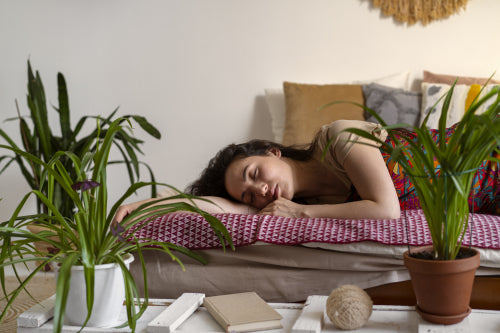Your bedroom should be a haven of relaxation and comfort, a space where you can unwind and recharge. Incorporating plants into your bedroom dcor can achieve just that by adding aesthetic charm and creating a healthier environment conducive to better sleep. Plants can purify the air, reduce stress, and even influence mood. Below, we explore the best plants for bedroom dcor and better sleep, offering tips on selecting, caring for, and styling these green companions.
Why Add Plants to Your Bedroom?
Plants are more than just decorative elements. Their benefits go beyond aesthetics:
Air Purification
Many plants are natural air purifiers, absorbing toxins like formaldehyde and benzene, releasing oxygen, and improving air quality. Cleaner air means better breathing and a healthier sleep environment.Stress Reduction
Greenery can have a calming effect on the mind, helping to lower stress and anxiety levels. Surrounding yourself with nature-inspired elements fosters tranquility and relaxation.Humidity Regulation
Certain plants release moisture into the air, maintaining an optimal humidity level that's good for skin and respiratory health.Improved Sleep Quality
Some plants release oxygen at night or have soothing scents that encourage restful sleep. Their presence can also promote mindfulness, reducing distractions and helping you unwind before bedtime.
Top 10 Plants for Bedroom Dcor and Sleep
1. Snake Plant (Sansevieria)
- Benefits: Known as the "Mother-in-Law's Tongue," the snake plant releases oxygen at night, making it an ideal bedroom choice. It also removes harmful toxins like formaldehyde and benzene.
- Care Tips: Thrives in low to moderate light; water sparingly as it doesn't like overwatering.
2. Lavender
- Benefits: Famous for its soothing scent, lavender reduces stress, lowers blood pressure, and aids relaxation for better sleep.
- Care Tips: Requires bright, indirect light and well-draining soil. Avoid overwatering.
3. Aloe Vera
- Benefits: A low-maintenance plant that releases oxygen at night and improves air quality. Its gel is also great for minor skin irritations.
- Care Tips: Needs bright, indirect light and minimal watering.
4. Peace Lily (Spathiphyllum)
- Benefits: A natural air purifier that also increases indoor humidity, making it easier to breathe. Its white blooms add elegance to your space.
- Care Tips: Prefers indirect light and consistent watering to keep the soil moist.
5. English Ivy (Hedera helix)
- Benefits: Known for its ability to reduce airborne mold and improve respiratory health, English Ivy is perfect for allergy sufferers.
- Care Tips: Place it in indirect light and keep the soil moist but not soggy.
6. Jasmine
- Benefits: Jasmine's delicate flowers emit a sweet fragrance that promotes relaxation and improves sleep quality.
- Care Tips: Needs bright, indirect sunlight and regular watering.
7. Areca Palm
- Benefits: This lush plant is a natural humidifier and air purifier, making it ideal for dry bedroom climates.
- Care Tips: Thrives in bright, indirect light and requires regular watering.
8. Chamomile
- Benefits: Famous for its use in tea, chamomile's tiny flowers give off a calming aroma that encourages sleep.
- Care Tips: Requires a sunny windowsill and regular watering.
9. Spider Plant (Chlorophytum comosum)
- Benefits: An excellent air purifier, the spider plant removes toxins like carbon monoxide while adding a touch of vibrancy to your room.
- Care Tips: Tolerates low light but thrives in bright, indirect sunlight. Water when the soil is dry.
10. Pothos (Epipremnum aureum)
- Benefits: Easy to care for and visually striking, pothos purifies air and is highly adaptable to various lighting conditions.
- Care Tips: Prefers indirect light and only needs watering when the soil is dry.
Styling Tips for Bedroom Plants
Mix Heights and Sizes
Combine tall plants like the Areca Palm with smaller ones like Lavender to create layers and depth in your dcor.Use Decorative Planters
Choose pots that match your bedroom's aesthetic, from minimalist ceramics to woven baskets, to enhance the visual appeal.Position Strategically
a) Place plants like Lavender or Jasmine near your bedside to enjoy their calming scent.
b) Use hanging planters for cascading plants like Pothos or English Ivy to save space.
c) Add a large plant like a Peace Lily in a corner to fill empty spaces elegantly.Keep It Balanced
Avoid overcrowding; too many plants can feel overwhelming. Start with 23 plants and adjust as needed.Consider Lighting
Place plants according to their light requirements. A south-facing window works well for light-loving plants, while low-light options thrive in shaded areas.
Caring for Bedroom Plants
Watering
Overwatering is a common mistake. Check soil moisture before watering and ensure pots have drainage holes to prevent root rot.Light
Rotate plants periodically to ensure all sides receive adequate sunlight. If your room lacks natural light, consider using grow lights.Pruning
Regularly trim dead leaves and flowers to maintain the plant's health and appearance.Dusting
Dust leaves gently to allow plants to absorb light efficiently and maintain a clean look.Pest Control
Inspect plants for pests like spider mites or mealybugs. Use natural remedies like neem oil if needed.
The Science Behind Plants and Sleep
Plants contribute to better sleep through two key mechanisms:
Air Quality Improvement
Many bedroom-friendly plants absorb carbon dioxide and release oxygen, creating a fresher atmosphere. They also filter out toxins and allergens that might disrupt sleep.Psychological Impact
The presence of greenery has been shown to reduce cortisol levels (the stress hormone), encouraging relaxation. Fragrant plants like Lavender and Jasmine further stimulate the brain to release calming neurotransmitters.
Common Concerns About Bedroom Plants
Do Plants Steal Oxygen at Night?
While some plants consume oxygen during the night, the amount is negligible and not harmful. In fact, plants like Snake Plant and Aloe Vera release oxygen at night, making them ideal bedroom choices.Allergies and Plants
Choose hypoallergenic plants like Spider Plant or Peace Lily if you're sensitive to pollen.
Improve Sleep Quality
Adding plants to your bedroom is a simple yet powerful way to improve your sleep quality and enhance your dcor. From air-purifying wonders like Snake Plant and Spider Plant to fragrant gems like Lavender and Jasmine, there's a plant for every need and style. By following proper care tips and strategically styling your plants, you can create a serene sanctuary that promotes relaxation and rejuvenation.
Transform your bedroom into a green haven today, and enjoy the countless benefits these plants bring to your space and sleep.
You may also be interested in: Hainbuchenhecke Pflanzen und Pflegen: Ein umfassender ...
Discover your gardening joy with a top selection. Your joy and green happiness begin here. Shop Now
Powered by flareAI.

